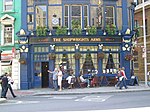SeOne
2002 establishments in EnglandMusic venues completed in 2002Nightclubs in London

seOne was a nightclub in London, United Kingdom. It claimed to be London's largest licensed nightclub with a capacity of 3,000 people. It was located on Weston Street underneath the London Bridge transit centre. The licensing authority required the nightclub to scan and retain clubbers' ID details. seOne used Clubscan for this purpose. On 22 February 2010 it officially closed down due to financial difficulties.On 21 May 2010 it reopened as Debut London, a live music and club venue. Debut London later closed, and the venue was demolished as part of the redevelopment of London Bridge station.
Excerpt from the Wikipedia article SeOne (License: CC BY-SA 3.0, Authors, Images).SeOne
More London Place, London Borough (London Borough of Southwark)
Geographical coordinates (GPS) Address Nearby Places Show on map
Geographical coordinates (GPS)
| Latitude | Longitude |
|---|---|
| N 51.504161111111 ° | E -0.084725 ° |
Address
London Bridge
More London Place
SE1 2DA London, Borough (London Borough of Southwark)
England, United Kingdom
Open on Google Maps









